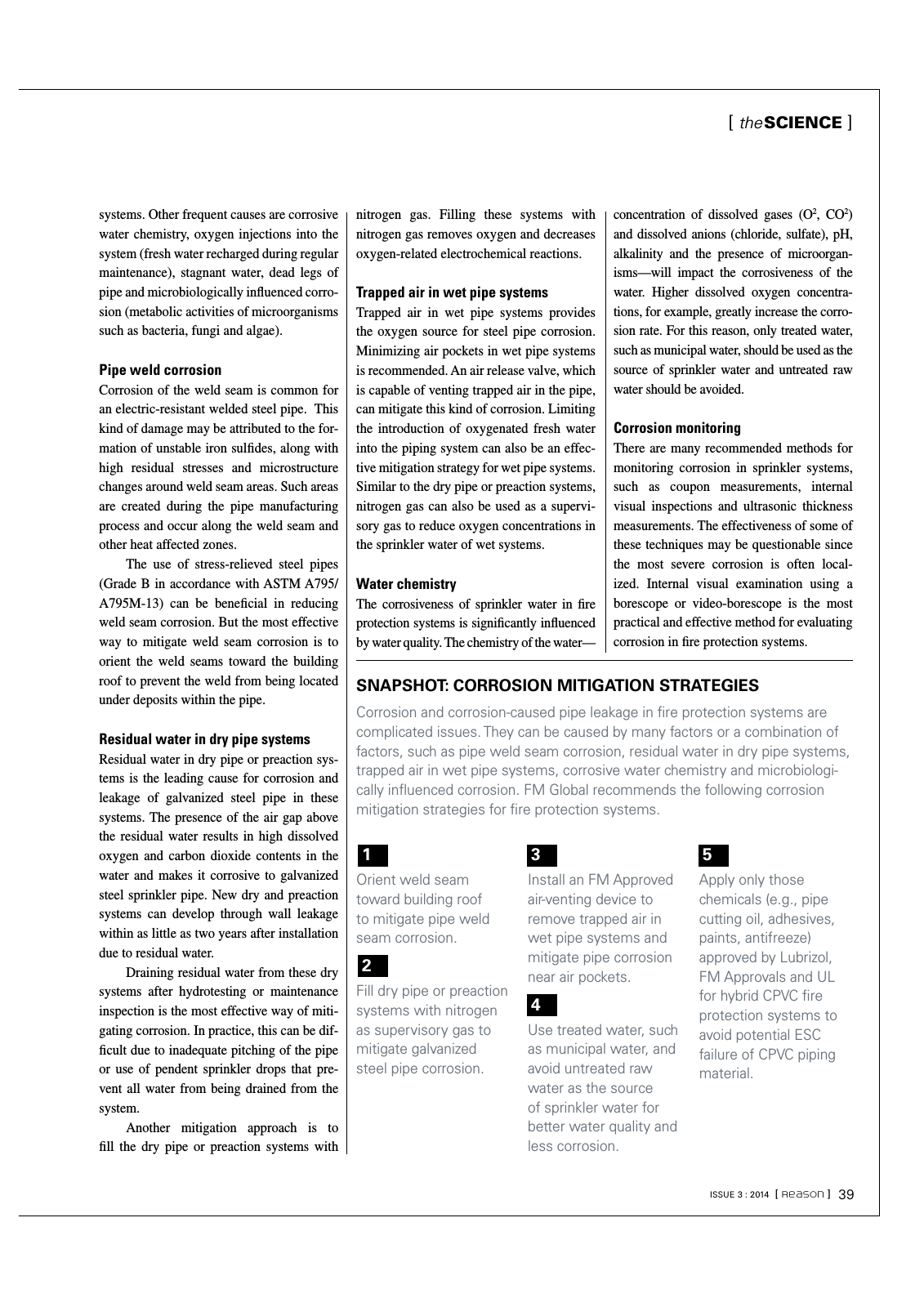Reason Magazin 2014Q3 Seite 39
Hinweis: Dies ist eine maschinenlesbare No-Flash Ansicht.Klicken Sie hier um zur Online-Version zu gelangen.
Inhalt
systems Other frequent causes are corrosive water chemistry oxygen injections into the system fresh water recharged during regular maintenance stagnant water dead legs of pipe and microbiologically influenced corro sion metabolic activities of microorganisms such as bacteria fungi and algae Pipe weld corrosion Corrosion of the weld seam is common for an electric resistant welded steel pipe This kind of damage may be attributed to the for mation of unstable iron sulfides along with high residual stresses and microstructure changes around weld seam areas Such areas are created during the pipe manufacturing process and occur along the weld seam and other heat affected zones The use of stress relieved steel pipes Grade B in accordance with ASTM A795 A795M 13 can be beneficial in reducing weld seam corrosion But the most effective way to mitigate weld seam corrosion is to orient the weld seams toward the building roof to prevent the weld from being located under deposits within the pipe Residual water in dry pipe systems Residual water in dry pipe or preaction sys tems is the leading cause for corrosion and leakage of galvanized steel pipe in these systems The presence of the air gap above the residual water results in high dissolved oxygen and carbon dioxide contents in the water and makes it corrosive to galvanized steel sprinkler pipe New dry and preaction systems can develop through wall leakage within as little as two years after installation due to residual water Draining residual water from these dry systems after hydrotesting or maintenance inspection is the most effective way of miti gating corrosion In practice this can be dif ficult due to inadequate pitching of the pipe or use of pendent sprinkler drops that pre vent all water from being drained from the system Another mitigation approach is to fill the dry pipe or preaction systems with SNAPSHOT CORROSION MITIGATION STRATEGIES Corrosion and corrosion caused pipe leakage in fire protection systems are complicated issues They can be caused by many factors or a combination of factors such as pipe weld seam corrosion residual water in dry pipe systems trapped air in wet pipe systems corrosive water chemistry and microbiologi cally influenced corrosion FM Global recommends the following corrosion mitigation strategies for fire protection systems nitrogen gas Filling these systems with nitrogen gas removes oxygen and decreases oxygen related electrochemical reactions Trapped air in wet pipe systems Trapped air in wet pipe systems provides the oxygen source for steel pipe corrosion Minimizing air pockets in wet pipe systems is recommended An air release valve which is capable of venting trapped air in the pipe can mitigate this kind of corrosion Limiting the introduction of oxygenated fresh water into the piping system can also be an effec tive mitigation strategy for wet pipe systems Similar to the dry pipe or preaction systems nitrogen gas can also be used as a supervi sory gas to reduce oxygen concentrations in the sprinkler water of wet systems Water chemistry The corrosiveness of sprinkler water in fire protection systems is significantly influenced by water quality The chemistry of the water concentration of dissolved gases O2 CO2 and dissolved anions chloride sulfate pH alkalinity and the presence of microorgan isms will impact the corrosiveness of the water Higher dissolved oxygen concentra tions for example greatly increase the corro sion rate For this reason only treated water such as municipal water should be used as the source of sprinkler water and untreated raw water should be avoided Corrosion monitoring There are many recommended methods for monitoring corrosion in sprinkler systems such as coupon measurements internal visual inspections and ultrasonic thickness measurements The effectiveness of some of these techniques may be questionable since the most severe corrosion is often local ized Internal visual examination using a borescope or video borescope is the most practical and effective method for evaluating corrosion in fire protection systems Orient weld seam toward building roof to mitigate pipe weld seam corrosion Fill dry pipe or preaction systems with nitrogen as supervisory gas to mitigate galvanized steel pipe corrosion Install an FM Approved air venting device to remove trapped air in wet pipe systems and mitigate pipe corrosion near air pockets Use treated water such as municipal water and avoid untreated raw water as the source of sprinkler water for better water quality and less corrosion Apply only those chemicals e g pipe cutting oil adhesives paints antifreeze approved by Lubrizol FM Approvals and UL for hybrid CPVC fire protection systems to avoid potential ESC failure of CPVC piping material 1 2 3 4 5 ISSUE 3 2014 Reason 39 theSCIENCE
